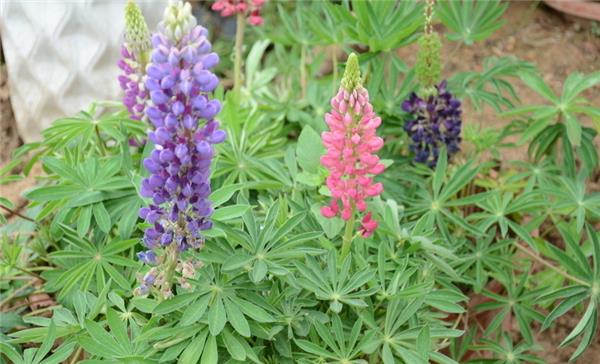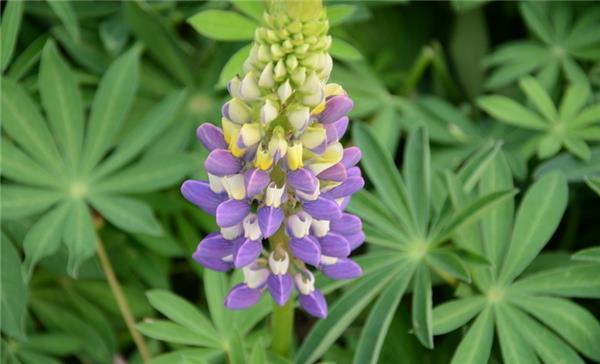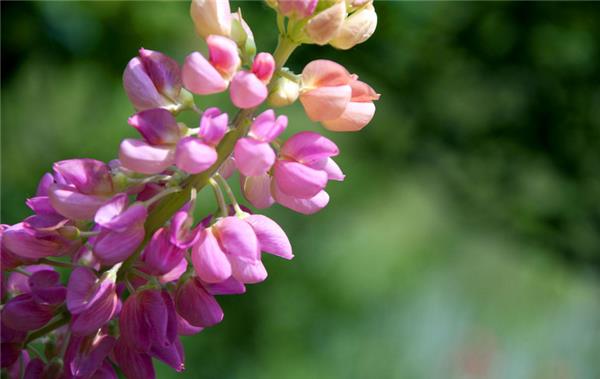The best companion of tea garden Lu Binghua introduction and cultivation methods
Lubing flowers are mainly distributed in western North America, South America, the Mediterranean region and Africa. The leaves are composed of many feathery leaflets growing on both sides of the petiole and have beautiful white, blue, yellow, or purple flowers. Some lupine varieties are grown in gardens, and some lupins cultivated in Europe are used as forage. One variety called cornflower is the state flower of Texas. Let's take a look at Lu Binghua's knowledge.

I. introduction of Lu Binghua
Lu Binghua is an annual herb, 20-70 cm high. Tea farmers in the mountains of Taiwan, especially Yunwu Tea, a mountain peculiar to Taiwan, need to plant "Lu Binhua" around Tea Mountain or even near tea plants, because this plant is said to help tea grow healthily and make tea fragrant and sweet. Lubinghua is a palmately compound leaf. Most of them are born at the base, with 10-17 leaflets, lanceolate to inverted-lanceolate, with thick leaves, smooth leaves and coarse hairs on the back. Raceme terminal, 40-60 cm high, steeple-shaped, colorful, common red, yellow, blue, pink, etc., 2 florets, lip-shaped, lateral erect, margin curled; keel bent. The pod is 3-4 cm long, the seed is large, brown and shiny, and the shape is flat and round. There are many varieties of horticulture. It is native to North America and grows in temperate regions of sandy land.
Lubinghua is a genus of leguminous plants, most of which are perennial herbs with a height of about 0.3 to 1.5 meters, while a few are annual plants and some are shrubs that can grow to more than 3 meters in height. Like many other legumes, lupins are also involved in nitrogen fixation.

Second, the ecological habits of Lubinghua.
The sex likes to be cool, sunny, avoid hot, slightly shady. Deep-rooted, few nodules. Born in sandy soil, acidic sandy loam with deep soil layer, loose fertility and good drainage (ph value 5.5) is required, and the plant growth of neutral and slightly alkaline soil is poor. Lupin, more hardy (more than-5 ℃), like cool climate, sunny places, avoid heat, slightly shade-resistant, need fertile, well-drained sandy soil, developed taproot, few fibrous roots, not resistant to transplantation. The root system is developed, drought tolerance, the most suitable for sandy soil, the ability to use insoluble phosphorus in phosphate is also strong. It can still grow in rainy, waterlogged areas and acidic soils where other plants are difficult to grow, but calcareous soils or poor drainage often lead to poor growth. It can tolerate an air temperature of 0 ℃, but freezes to death when the temperature is below-4 ℃. The extreme heat in summer also inhibits growth. Lupin is cool, sunny, hot and shade-resistant. Deep-rooted, few nodules. It is required that the soil layer is deep, fertile and loose, good drainage, acid sandy soil (pH value 5.5), neutral and slightly alkaline soil plant growth is poor. The seedling stage of lupin is 30 to 35 days, and the seedlings are transferred and planted after the true leaves are fully unfolded. The root system of lupin is well developed, and the original soil is retained when transplanting seedlings, which is beneficial to slow down the seedlings.

3. Cultivation techniques of Lubinghua.
The seedling stage of Lubing flower was 30-35 days, and the seedlings were transferred and planted after the true leaves were fully unfolded. The root system of lupin is well developed, and the original soil is retained when transplanting seedlings to promote seedling retardation. The pot should be changed twice according to the growth situation before planting, and the pot should be selected as a high barrel basin, in order to meet the growth needs of taproot roots and determine the reasonable planting density. For autumn sowing, corresponding cold prevention measures should be taken when overwintering, and the temperature should be above 5 ℃ to avoid freezing damage to leaves and affect the vegetative growth and ornamental effect in the early stage. Lu Bing flowers like cool, coupled with its own perennials, so in the summer high temperature management should pay special attention to prevent high temperature and humidity, sunburn caused by leaves yellowing, plant growth dwarf and even death. In the garden application, the lupine in the flowering stage can also be directly planted under the forest trees and in a cool and ventilated place to facilitate summer management. After watching potted plants, it is necessary to timely cut off the residual ears of flowers and withered old leaves, control fertilizer and water, and do a good job of shading protection in high temperature period to ensure safe summer.
IV. Culture methods of Lubinghua
According to the growth habits of Lupin, it is very important to control and regulate the pH (ph) of the culture medium during cultivation for the normal growth and flowering of Lupin. In general, a simple and effective regulation method is to apply sulfur powder to the cultivation substrate. As it takes a certain time for sulfur to decompose in the substrate (more than 40 days) to play a regulatory role, so the application should be carried out as soon as possible.
Generally, it starts when 2-3 true leaves appear after transplanting seedlings, and the application amount depends on the original pH of the culture medium. In addition, although acid fertilizers such as ferrous sulfate and aluminum sulfate can reduce ph in a short time, excessive salt ion concentration will cause toxicity to plant roots and should be used less in production. The pot should be changed one or two times according to the growth situation before planting, and the pot should be selected as a high barrel basin, in order to meet the growth needs of taproot roots and determine the reasonable planting density. For autumn sowing, corresponding cold prevention measures should be taken when overwintering, and the temperature should be above 5 ℃ to avoid freezing damage to leaves and affect the vegetative growth and ornamental effect in the early stage.

The lupin is cool, and it belongs to perennials, so special attention should be paid in summer to prevent leaves from yellowing, plant growth and even death caused by high temperature and humidity, sunlight and sun. In the garden application during the flowering period, it can also be planted directly under the forest trees and in a cool and ventilated place to facilitate summer management. After pot viewing, it is necessary to timely cut off the residual ear of flowers and withered leaves, control fertilizer and water, and do a good job of shading protection in high temperature period to ensure safe summer.
The above is the knowledge of Bingluhua. I hope I can help you.
The best choice of pot is high barrel basin, in order to meet the growth needs of taproot roots and determine the reasonable planting density. For autumn sowing, corresponding cold prevention measures should be taken when overwintering, and the temperature should be above 5 ℃ to avoid freezing damage to leaves and affect the vegetative growth and ornamental effect in the early stage.

The lupin is cool, and it belongs to perennials, so special attention should be paid in summer to prevent leaves from yellowing, plant growth and even death caused by high temperature and humidity, sunlight and sun. In the garden application during the flowering period, it can also be planted directly under the forest trees and in a cool and ventilated place to facilitate summer management. After pot viewing, it is necessary to timely cut off the residual ear of flowers and withered leaves, control fertilizer and water, and do a good job of shading protection in high temperature period to ensure safe summer.
The above is the knowledge of Bingluhua. I hope I can help you.
- Prev

Introduction and culture methods of ivy, a foreign plant from Europe
Introduction and culture methods of ivy, a foreign plant from Europe
- Next

Introduction and culture method of small plant reticulate grass in plaid shirt
Introduction and culture method of small plant reticulate grass in plaid shirt
Related
- Wuhan Hospital Iron Tree Blooming Result Was Instantly Frightened by the Gardener Master
- Which variety of camellia is the most fragrant and best? Which one do you like best?
- What is the small blue coat, the breeding methods and matters needing attention of the succulent plant
- Dormancy time and maintenance management of succulent plants during dormancy
- Minas succulent how to raise, Minas succulent plant pictures
- What are the varieties of winter succulent plants
- How to raise succulent plants in twelve rolls? let's take a look at some experience of breeding twelve rolls.
- Attention should be paid to water control for succulent plants during dormant period (winter and summer)
- Watering experience of twelve rolls of succulent plants
- Techniques for fertilizing succulent plants. An article will let you know how to fertilize succulent plants.

